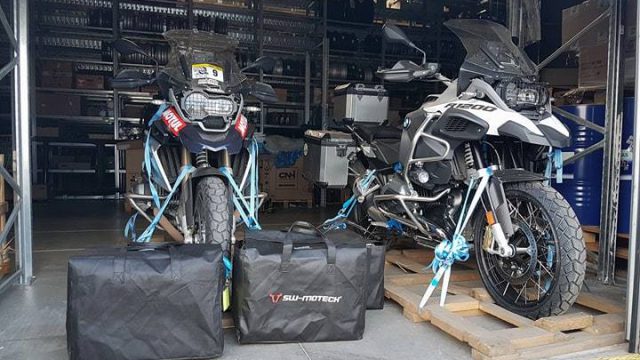What type of luggage? What kind of equipment? And how many pairs of underwear do you need
Three weeks left. My bike is somewhere in a container, while I’m reading as many things as I can and studying the maps with a Magellanian passion. But before that, it was the luggage. What type of luggage system should you choose? What kind of equipment? Is the Gore-Tex enough or should you also take a rain suit? And, of course, how many pairs of underwear do you need in a five-weeks trip? It all depends on the purpose and the destination, but here are my choices.
What type of luggage: soft-bags vs. plastic panniers vs. aluminium cases
Each one above has a specific purpose. There are some ups and downs when choosing one thing over another, so you must decide which aspect is more important for you: the weight, the shape, the resistance. Here’s a short description of each one of them:
Soft-bags: the lightest over here. That’s why they are the best solution if planning to go off-road. Less weight, more fun. Usually cheaper than plastic and aluminum, but if you want a high-quality product, you should be aware that it comes with a price. The weakness: not so comfortable to pack and unpack daily, not 100% waterproof (there’s always a zipper you forget about), not as roomy as a big aluminum box.

Cristian Scutariu (a friend of mine) on his way to Magadan, crossing Siberia alone. He picked the soft bags for this trip.
Plastic panniers: usually popular on touring and sport-touring bikes because they can be built in an aerodynamic shape. They are heavier than soft-bags and not very resistant when falling. It depends on the manufacturer. For example, the original Africa Twin plastic cases are not as resistant as the original BMW Vario cases. Also, the Vario cases have an adjustable capacity so you can get a wider/narrower bike. Other downsides: they can be loaded from the side – not the most comfortable way, and they are not very functional.

Pictured above: My R1200GS, last summer, with the origina Vario cases. I was travelling to Nordkapp, Norway.
Aluminium cases: most popular on adventure motorcycles. The might bend when falling off, but you can repair them using a hammer. Very functional – you can easily put a tent on top of a sidebox, and you can drill some holes in the aluminium box to attach fuel canisters. Downsides: heavier than soft-bags and very expensive – a set (mounting kit included) is about $1,600.
My choice: aluminium cases. It’s not an off-road-oriented trip. Most of the time I’ll be on the asphalt, and I know that I’ll handle the extra weight. I have a lot of rainy days ahead time and I want to protect my electronic filming equipment. The bike: a 2015 R1200GS.

Our bikes, ready for shipping
Motorcycle Equipment
I’m using a functional, three-layer, highly ventilated adventure-touring textile equipment. That’s because I must be prepared for all kind of temperatures, from the desert heat to high mountain roads that come with lots of rain. Besides the equipment’s waterproof membrane I took a rain suit with me. What I learned in all these years is that no membrane is good enough.
So, when it’s hot outside I can open the ventilations and only use the outer shell. When it’s cold, I have a water/wind membrane, a thermic layer, my first body layer and even the rain suit. It should be enough. My bike is a 2015 R1200GS with heated grips and high windscreen so I have more than decent weather protection.
Thee pairs of gloves: summer, intermediate, winter gloves.
A buff-type headwear.
Two long-sleeve base layers (summer/winter) and three short-sleeve base layers. One base-layer pant.

Pictured above: my adventure gear during a V-Strom 650 Test-Ride
“Civilian” clothes
Jeans, a pair of pants, a pair of cargo shorts, a swim short, a shirt, three t-shirts and a blazer. Then, a cap, a winter hat, some UV sunglasses and some trekking gloves. Sport/trekking shoes. Oh, and yeah, how many pairs of underwear do you need? Well, you can’t have a full-of-boxers side-case so make sure you have enough underwear for a week. After that, you’ll find a nice apartment or hotel that has a washing machine.
A good sleeping bag is essential when traveling in some unknown places without a platinum credit card. Still, no matter the cash, you won’t find a four-five star hotel in a far-away village. This time I won’t bring my tent with me.
Survival Items and other things + Photo/video
A swiss knife, medical kit, motorcycle tools, headlamp, Spot rescue tracker, power bank, photo video equipment, papers and duplicates, phone. We’ll talk about these things next time.
Remember! When packing, put the heavy items at the base and the light ones above. I usually put the civilian clothes in the left case (it’s larger), and the motorcycle equipment goes in the right case, while the miscellaneous things are in the top-case. I’m using a roll-bag for the sleeping bag and for other things.






What are your thoughts on tools and technical equipment like mini compressor, tire repair kit etc